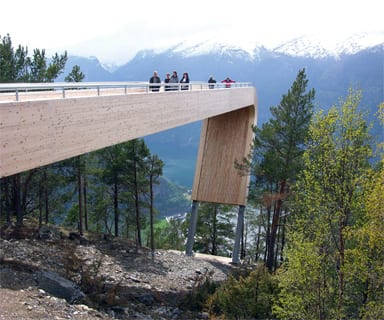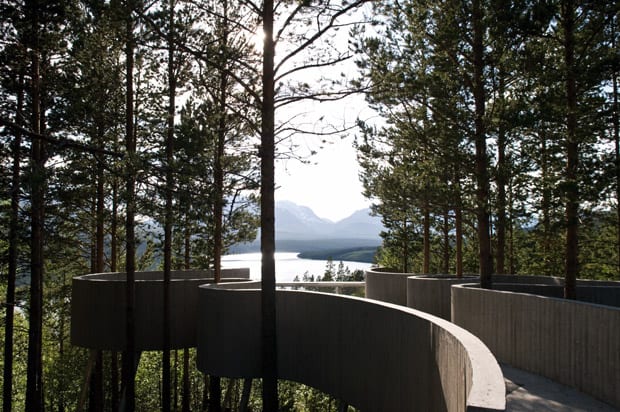
words Beatrice Galilee
Top image
Sohlbergplassen, Rondane
By Carl Viggo
HØlmebank, 2005
How can you improve a view that is already sublime? Norway’s untouched coasts, fjords and mountain valleys offer some of the most dramatic vistas in Europe, but by their nature they are pretty difficult to get to. How do you help people appreciate a wilderness without it ceasing to be one?
At Sohlbergplassen, on the edge of the Rondane National Park in the heart of Norway, the answer is: look but don’t touch. A concrete viewing platform spills between the trees, surrounding one, but touching none, parting to reveal a still lake and blue white-tipped mountains. It is just one of a clutch of buildings, platforms, lookout points, bridges, benches and toilets built by over 40 Norwegian architects for the country’s National Tourist Routes, and the first of many we will visit on our four-day, 1,000 mile road trip.
We, by the way, are two architectural tourists: one driver and one writer, here to track down as many of these poetically designed amenities and pauses as we can in a trip covering four tourist routes around the blissful Norwegian mountains along the western coastline and across the centre of the country. We’re wholly unprepared for the rigours of a landscape that is, although very beautiful, empty and vast. We set off with what we consider to be generous supplies: three compilation CDs, two digital cameras, several packets of fizzy sweets and a rough guide to Norway. This lasts us until about two hours out of Oslo. For hundreds of miles of barren tundra, there are no other road users but sheep and the occasional caravan.
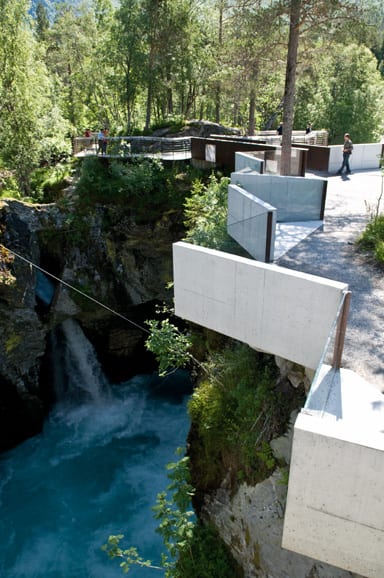
Since 1997, the Norwegian government has invested heavily in 18 tourist routes, which wrap around the most scenic and beautiful climbs of the country. New interventions are being commissioned and completed every year, and the scheme has become a launchpad for a number of young architects and a feather in the cap for more established firms like Snøhetta and Jensen + Skødvin.
Tourism, we discover, is something relatively new to rural Norway. The small farming and fishing villages are suffering from slowly depleting populations as the next generation slips off into the cities, and tourism is the inevitable step for these remote but beautiful regions. However, the small mountain hamlets we drive through are insular, and unlike historic Swiss or Austrian Alpine fiefdoms with quaint, friendly inns, patisseries or pensions along the way, our daytime sustenance invariably arrives through overpriced and tepid bacon-wrapped hotdogs bought at great expense at roadside petrol stations. So, despite the project’s noble intentions, if they are hoping to bring in anyone outside of the caravanning community they might like to think about opening up a restaurant or two. In context, this is a minor gripe. At Sohlbergplassen, a cafe by the same architect as the platform will open next year, but at the moment there are no amenities at all, not so much as a bin. Because of this, however, it’s all about the view, and it’s difficult to see how, even with an empty stomach, this could be anything other than absolute joy to anyone who comes across it.
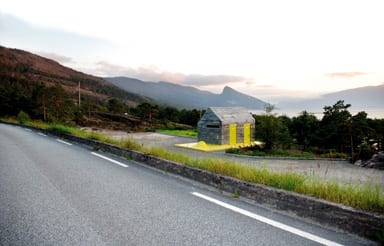
All the four routes we visit in our little Toyota offer some of the most spectacular and varied scenery I’ve ever seen. “Bloody-hellic” is the most appropriate adjective that comes to mind in response to these often shockingly beautiful and dramatic sites. The craggy rocks surrounding the Romsdal valley are glassy with water as the heavy glaciers at their summit melt, dropping their load in a spectacularly noisy fashion through the deep incisions that line their cliff faces. At the icy, snowy peaks of the Trollstigen mountain we pass bare-chested Nordic skiers as they puff and push themselves along frozen glaciers in jaw-dropping car-advert territory. In Turtagrø the scenery looks more like a dense Canadian forest or a scene from Lord of the Rings.
An epic snowball fight (which I lose miserably), a confused altercation with some Swedish bikers and a ferry ride later, we arrive at the still waters of the Aurlandsfjord, a beautiful, quiet, Italianate village. Given the wealth of natural material, it is inevitable that any man-made marks on this landscape would have to be highly considered. The Norwegian philosophy on this can be traced back to the country’s great modernist architect, Sverre Fehn. Architecture, if carefully considered as an incision on the landscape, he argues, can easily serve to elevate nature without competing with it. The scenery is evidently sublime, and though there are many lay-bys where we can happily stop and gawp, it is something quite different to be provided with a thoughtful intervention. When a structure levitates over a gushing waterfall, it offers more than just a photo opportunity, it’s an experience in itself. In other places it is about framing, highlighting, pulling the car to a halt, lifting the senses for a moment. Or in the case of toilets and rest areas, it is about creating facilities that surpass their mundane function and add something unexpected to an area of beauty. The ambitious nature of this project, to have high quality architecture thoughtfully placed along the landscape, is not only admirable, it’s a valuable opportunity for young architects to spread their wings in a newly wealthy country better known for its oil rigs than for its architecture.
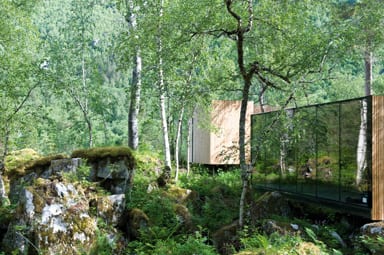
A day of hairpin bends through cavernous drops in the Isterdalen valley, crossing through waterfalls and waiting nervously for coaches and caravans to pass, brings us to our next stop, Trollstigen. At the very top of a mountain overlooking a deafening waterfall, an understated, rusty-metal, gate-like structure leads an assured, if slightly angular, way over the rushing water to a viewing platform poised over the cliff face – offering the chance to venture into the air and get a bit of wet mist on your face. It has only been open for two days and tourists wander gingerly over the bridge and look anxiously down, clutching their digital cameras. The braver have already wandered onto the rocks below. This is the only place where it feels as if the Norwegian authorities have got the idea about tourism. Little shops are selling reindeer skins and miniature trolls, wizards and snowflake jumpers. In 2009 there will be two new buildings here – a cafe and a further viewing point.
There are some rather more awkward projects at Geiranger, at the other end of Route 63 from Trollstigen, more than 100km away. The curved metal railings that cross this difficult site are clunky, gratuitous and annoying. Although they take a beautiful photograph, the angular concrete with glass is superfluous and difficult when compared to the rather humble and sophisticated concrete structure we saw on the first day. They seem too keen to assert themselves rather than allowing the viewer to wander and pause. At nearby Flydalsjuvet, there is a similar example of the problems that arise when designs appear to have been created without a clear relationship to the site. Benches are pretty crucial bits of infrastructure, and to see long concrete monoliths at Flydalsjuvet lie empty as groups of tourists sit on rock edges and press up to wires is disheartening. These benches could have been in a town square in Rotterdam.
Up and around the corner from Geiranger is the house of Knut Slinning, a property developer. His project, the Juvet Hotel, is part of the tourist route but is something very special indeed. Slinning has an ambitious plan that is not about passing trade from tourists but about reinvigorating the economy of the village itself. In a patch of forest by a brook, Jensen + Skødvin has designed a handful of little timber-clad Miesean pods with floor-to-ceiling windows. Slinning will put on a host of “Norwegian” holiday activities – skiing, hiking, rafting and so on – making use of existing skills in the area. Eventually he wants to build a spa resort on the same site and affordable housing on the mountains – something to bring life back to this area and give young people a reason to stay.
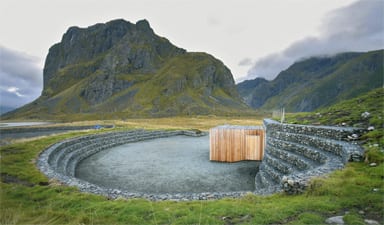
It takes a whole day of driving through long switchbacks up and down the sides of glacial valleys to reach the most famous lookout point of the batch, one that truly deserves to be a destination in its own right. For someone who once cried at the mere idea of going up 50 floors in a glass lift, Stegastein has nightmarish terror written all over it. The lookout point, designed by Todd Saunders and Tommie Wilhelmsen, is a bit like walking the plank over the Grand Canyon; as one approaches the end of the thing it just drips over and disappears like the top of an escalator, but with a sheer drop instead of steps. There is only a tiny layer of protection between certain death – a piece of glass, tilted forwards to add to the drama. Actually, it’s all drama. It’s not particularly high – it is supported a few metres beneath on this shallow part of the mountain climb – but the cleverness makes it all the better. It’s a self-conscious play on several ideas, from the simple act of looking at a view to the heightening and manipulating of experience.
After Stegastein, on the road to Bergen airport, the landscape flattens out and a monotonous series of tunnels obliterates the last of the mountain views. Covering these huge distances is exhausting, which is one of the reasons these little interventions exist. They’re intended to be ways of breaking up or heightening the experience of a long journey, not destinations in their own right, as we saw them. They’re places to take a moment and sit, breathe and take in the view. By 2015, all 18 tourist routes will have been improved, and every one of them will be studded with these special places, including a monument to witchburning by Peter Zumthor with artist Louise Bourgeois. By that point we hope that the projects will have settled into their relative areas with just a little more tourist infrastructure. Niagara Falls-style bright lights and themed restaurants are not necessary, but sometimes a latte and an apple strudel can really help you appreciate a good view.
